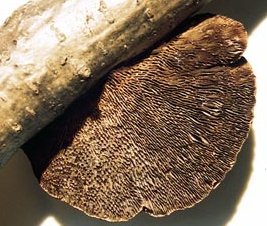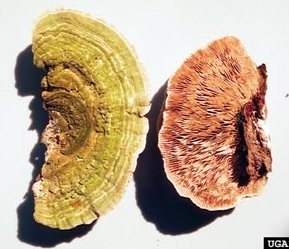The gilled polypore, Lenzites betulina (L.) Fr.
Common names
Multicolor gill polypore
Kaigaratake (Japanese)
Gilled polypore
Birch mazegill
Description
Fruiting body: up to 10 cm in diameter; leathery and flexible; upper surface tomentose; grayish or grayish-brown with multicolored zones, often with a green algal growth.
Flesh: white; leathery to corky.
Pore surface: lamellate, with occasional pores, whitish.

Spore print: white.
Spores: cylindric; smooth, 4-7 x 1.5-3 µm.
This common species grows scattered or clustered on deciduous wood such as birch, beech and oak, and less frequently on coniferous woods. Viewed from the top, it is similar in appearance to Trametes versicolor or Trametes hirsuta, sometimes with a greenish tinge from algal growth. However, it can be easily distinguished from the Trametes because it has gills instead of pores.

My name is Austin Collins.
I've dedicated my life to Mushrooms.
I believe Mushrooms are the best kept secret when it comes to health and well being.
For that reason, I would like to share a company with you that in my opinion makes the best mushroom products on the market.
The company is called Noomadic Herbals, my favorite supplement they make is called "Mushroom Total".
I take their products every day and they have helped me think better and have more energy. Give them a try.
-Austin
Uses in traditional Chinese medicine
L. betulina has been used for haunch and femora pain, acropathy, apoplexy, and cold (Liu B. Medicinal fungi of China. Taiyuan: Sanxi People Press; 1978. p.101, 129. Cited in Ren et al., 2006)
Culture
Over fifty years ago the German scientist Lohwag demonstrated that fruiting bodies of Lenzites betulina could be grown on a medium of malt peptone agar with an admixture of beech sawdust (Lohwag, 1955).
Medicinal properties
Anti-tumor
A water extract of Lenzites betulina was first shown to demonstrate mild anti-tumor activity against Sarcoma 180 (highly malignant tumor cells in mice) (Ikekawa et al., 1968).
Both the petroleum ether and the ethyl acetate extracts of Lenzites betulina were toxic to Hela (human cervix epitheloid) and SMMC-7721 (human hepatoma) tumor cell lines, compared to the positive control, quercetin. The methanol extract was also tested, but showed little cytotoxicity. The data in the table below gives the IC50 values – the concentration of extract needed to kill 50% of the cells. Note that the smaller the IC50 value, the greater the cytotoxic effect. The observed cytotoxic activity was likely due to fats and steroids (from the petroleum ether extract) and terpenoids (from the ethyl acetate extract). The data is summarized from Ren et al., 2006.
Extract type | Hela IC50 (µg/ml) | SMMC IC50 (µg/ml) |
Petroleum ether | 69.6 | 70.2 |
Ethyl acetate | 50.9 | 48.7 |
Methanol | 341 | 325 |
Quercetin | 46.3 | 43.1 |
Antioxidant activity
Two compounds isolated from the methanol extract of L. betulina, named betulinans A and B, showed free-radical scavenging activity. Because free radicals have been implicated in the origin and development of various diseases (e.g., ischemia, atherosclerosis, diabetes, rheumatoid arthritis, and cancer-initiation), betulinans A and B have potential as protective agents. In a test of free-radical scavenging strength, betulinan A was about four times as effective as vitamin E (Lee et al., 1996).
Immunosuppressant drugs inhibit the activity of the immune system. Clinically, they are used to prevent the rejection of transplanted organs or tissues, and in the treatment or management of autoimmune diseases. The methanolic extract of Lenzites betulina was shown to contain the immunosuppressive compounds ergosterol peroxide and 9(11)-dehydroergosterol peroxide (Fujimoto et al., 1994).
The antimicrobial activities of various extracts of L. betulina were examined on the test microorganisms Escherichia coli, Enterobacter aerogenes, Salmonella typhimurium, Pseudomonas aeruginosa, Staphylococcus aureus, Staphylococcus epidermidis, Bacillus subtilis, Candida albicans, and Saccharomyces cerevisiae. The L. betulina extracts were midly antimicrobial towards three of these microorganisms. The results are summarized in the table below. The compounds responsible for the antimicrobial activity were heat-stable (Yamac and Bilgili, 2006).
Extract type | S. aureus | S.epidermidis | B.subtilis |
Chloroform | – | – | + |
Ethyl acetate | – | + | + |
Dichloromethane | – | – | + |
Acetone | + | + | + |
Ethanol | – | + | + |
Antitumor activity
Polysaccharides extracted from the mycelial culture of L. betulina and administered intraperitoneally into white mice at a dosage of 300 mg/kg inhibited the growth of Sarcoma 180 and Ehrlich solid cancers by 90% (Ohtsuka et al., 1973).
References
Ikekawa T, Nakanishi M, Uehara N., Chihara G. Fukuoka F.
Anti-tumor action of some basidiomycetes, especially Phellinus linteus.
Jap J Cancer Res. 1968 (59):155-7.
Fujimoto H, Nakayama M, Nakayama Y, Yamazaki M.
Isolation and characterization of immunosuppressive components of three mushrooms, Pisolithus tinctorius, Microporus flabelliformis and Lenzites betulina.
Chem Pharm Bull (Tokyo). 1994 42(3):694-7.
Lee IK, Yun BS, Cho SM, Kim WG, Kim JP, Ryoo IJ, Koshino H, Yoo ID.
Betulinans A and B, two benzoquinone compounds from Lenzites betulina.
J Nat Prod. 1996 59(11):1090-2.
Lohwag K.
[Growth experiments with Lenzites betulina (L.) Fr.] German.
Ost. bot. Z. 1955 102(4-5):524-8.
Ohtsuka S, Ueno S, Yoshikumi C, Hirose F, Ohmura Y, Wada T, Fujii T, Takahashi E.
Polysaccharides having an anticarcinogenic effect and a method of producing them from species of Basidiomycetes.
UK Patent 1331513, 26 September 1973.
Ren G, Liu XY, Zhu HK, Yang SZ, Fu CX.
Evaluation of cytotoxic activities of some medicinal polypore fungi from China.
Fitoterapia. 2006 77(5):408-10.
Yamac M, Bilgili F.
Antimicrobial activities of fruit bodies and/or mycelial cultures of some mushroom isolates.
Pharm Biol. 2006 44(9):660-7.



It is stated that this mushroom is immunosuppressant. What benefit can this be to take if you are already enjoying good health? Thanks in advance for your reply, Mushroom Guy!
Immunosuppresants are rarely beneficial for regular individuals. The rare cases they are used are for autoimmune diseases (Ex. Crohns or Lupus) or to prevent your body from rejecting an organ transplant. If you’re looking for a medicinal mushroom that is beneficial for regular individuals, we recommend Noomadic’s Mushroom Total which is a blend of top 5 medicinal mushrooms.
What benefits are there in making a “tea” or infusion by boiling them and drinking the hot water?
Is there anyway I can prepare them for myself when finding in the wild?
You say “Pore surface: lamellate, with occasional pores, whitish” but both of your pictures of the underside show shades of brown. Which is correct?